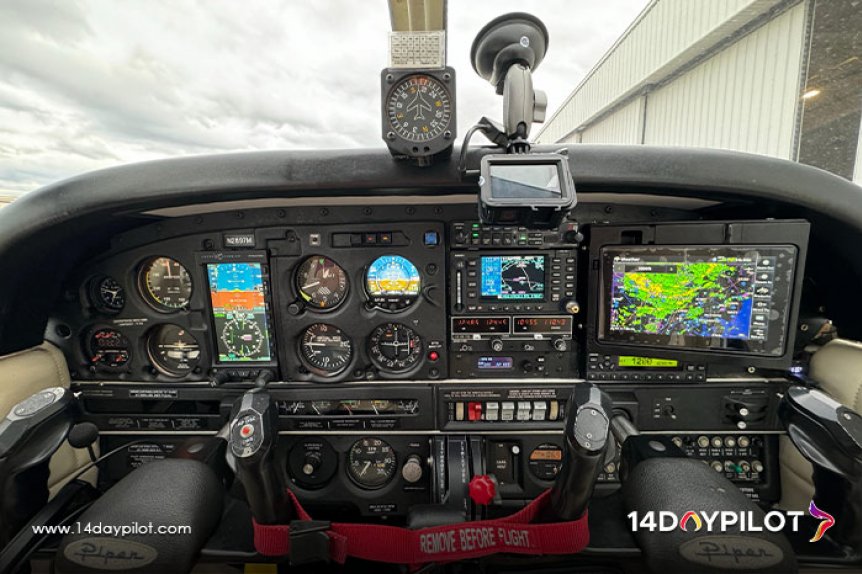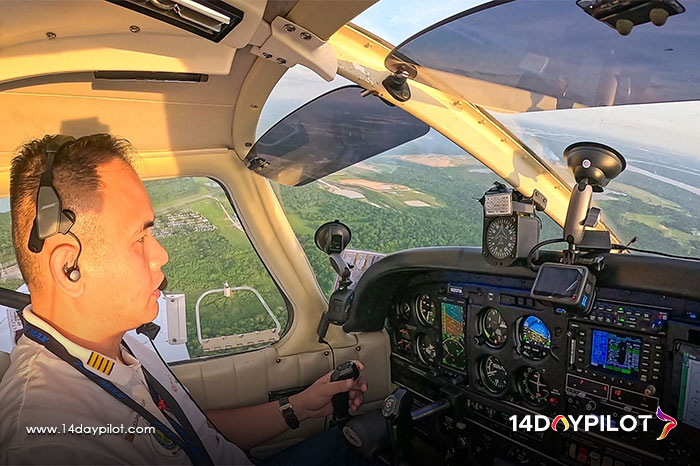
That’s why mastering modern avionics isn’t just an advantage; it’s a necessity. Today’s pilots don’t just rely on basic controls, they use cutting edge avionics to navigate, communicate, and make split-second decisions with confidence.
At 14DAYPILOT, we go beyond teaching you how to fly. We prepare you to navigate the skies with the same modern avionics technology found in commercial airlines and today’s most advanced aircraft.
Read More: Check Ride Preparation: Instructor Tips to Avoid Mistakes
A few decades ago, pilots relied on round dials and analog needles to track airspeed, altitude, heading, and more. These are called basic flight instruments, and they were effective, but required a lot of mental calculations and multitasking.
Today, those classic instruments have been replaced with digital displays known as glass cockpits. These systems give pilots real-time, easy-to-read data on a single screen. This reduces confusion, improves reaction time, and helps prevent errors.
So, what are avionics used for in modern planes? Everything. They help navigate, monitor engine performance, guide approaches, avoid weather, communicate with ATC, and even manage fuel. In short, avionics technology is the digital brain of an aircraft.

14DAYPILOT Chief Flight Instructor flying the PA28-161 with Autopilot (TAA)
(Source Image: Documentation by 14DAYPILOT)
Flying isn’t just about keeping the wings level anymore. Today’s pilots must manage vast amounts of information, analyze data, and make quick, informed decisions this is where modern avionics play a crucial role.
So, why are avionics essential in modern aircraft?
Digital systems provide real-time views of terrain, weather, and traffic.
Automated alerts and corrections help prevent accidents before they happen.
Features like auto-throttle and route optimization save both fuel and time.
Advanced radios, GPS, and ADS-B keep pilots connected with ATC and other aircraft.
That’s why at 14DAYPILOT, our fleet is equipped with cutting-edge avionics, including Garmin GNS 530W, GPS WAAS, and Aspen systems, depending on the aircraft model. These are the same tools used in professional airline training, ensuring our cadets master the technology they’ll use in real-world aviation.

Basic Six Pack and IFR Rated Airplane
(Source Image: Documentation by 14DAYPILOT)
At 14DAYPILOT Flight Academy, modern avionics training is a top priority. Unlike other schools that still rely on basic analog setups, we ensure every student learns with cutting edge technology from day one. From setting up GPS navigation to managing autopilot modes, our students gain hands-on experience with advanced avionics, just like professional pilots.
Read More: FAA Check Ride Guide: Do’s and Don’ts for Success
Even in IFR (Instrument Flight Rules) courses, we emphasize mastering digital tools used in low visibility and complex flight operations. This approach gives our cadets the confidence and skills to navigate real-world aviation challenges, setting 14DAYPILOT apart as a leader in modern flight training.
The future of aviation is undeniably digital. Aircraft manufacturers are building smarter planes. Airlines are demanding tech-savvy pilots. And airspace is getting busier, requiring more automation and precision.
By learning how to fly using modern avionics from the start, 14DAYPILOT students are not just getting a license they’re getting a real-world advantage.
If you're dreaming of becoming a pilot who’s not just skilled but ready for the future, then it’s time to train with the tools that the future demands. It’s time to fly smart, fly modern, and fly with 14DAYPILOT Flight Academy. Start training now!

Modern avionics have completely changed how pilots fly. From sleek digital displays to automated flight systems, technology now plays a huge role in making flights safer, smarter, and more efficient. But with these advancements comes a new challenge, aspiring pilots need to keep up.
That’s why mastering modern avionics isn’t just an advantage; it’s a necessity. Today’s pilots don’t just rely on basic controls, they use cutting edge avionics to navigate, communicate, and make split-second decisions with confidence.
At 14DAYPILOT, we go beyond teaching you how to fly. We prepare you to navigate the skies with the same modern avionics technology found in commercial airlines and today’s most advanced aircraft.
Read More: Check Ride Preparation: Instructor Tips to Avoid Mistakes
A few decades ago, pilots relied on round dials and analog needles to track airspeed, altitude, heading, and more. These are called basic flight instruments, and they were effective, but required a lot of mental calculations and multitasking.
Today, those classic instruments have been replaced with digital displays known as glass cockpits. These systems give pilots real-time, easy-to-read data on a single screen. This reduces confusion, improves reaction time, and helps prevent errors.
So, what are avionics used for in modern planes? Everything. They help navigate, monitor engine performance, guide approaches, avoid weather, communicate with ATC, and even manage fuel. In short, avionics technology is the digital brain of an aircraft.

14DAYPILOT Chief Flight Instructor flying the PA28-161 with Autopilot (TAA)
(Source Image: Documentation by 14DAYPILOT)
Flying isn’t just about keeping the wings level anymore. Today’s pilots must manage vast amounts of information, analyze data, and make quick, informed decisions this is where modern avionics play a crucial role.
So, why are avionics essential in modern aircraft?
Digital systems provide real-time views of terrain, weather, and traffic.
Automated alerts and corrections help prevent accidents before they happen.
Features like auto-throttle and route optimization save both fuel and time.
Advanced radios, GPS, and ADS-B keep pilots connected with ATC and other aircraft.
That’s why at 14DAYPILOT, our fleet is equipped with cutting-edge avionics, including Garmin GNS 530W, GPS WAAS, and Aspen systems, depending on the aircraft model. These are the same tools used in professional airline training, ensuring our cadets master the technology they’ll use in real-world aviation.

Basic Six Pack and IFR Rated Airplane
(Source Image: Documentation by 14DAYPILOT)
At 14DAYPILOT Flight Academy, modern avionics training is a top priority. Unlike other schools that still rely on basic analog setups, we ensure every student learns with cutting edge technology from day one. From setting up GPS navigation to managing autopilot modes, our students gain hands-on experience with advanced avionics, just like professional pilots.
Read More: FAA Check Ride Guide: Do’s and Don’ts for Success
Even in IFR (Instrument Flight Rules) courses, we emphasize mastering digital tools used in low visibility and complex flight operations. This approach gives our cadets the confidence and skills to navigate real-world aviation challenges, setting 14DAYPILOT apart as a leader in modern flight training.
The future of aviation is undeniably digital. Aircraft manufacturers are building smarter planes. Airlines are demanding tech-savvy pilots. And airspace is getting busier, requiring more automation and precision.
By learning how to fly using modern avionics from the start, 14DAYPILOT students are not just getting a license they’re getting a real-world advantage.
If you're dreaming of becoming a pilot who’s not just skilled but ready for the future, then it’s time to train with the tools that the future demands. It’s time to fly smart, fly modern, and fly with 14DAYPILOT Flight Academy. Start training now!
Hawra Tustari is an active aviation blogger who has high interest and expectations for the aviation industry. She is also an FAA Private Pilot who currently on a training to upgrade her licenses. Always up to date with the latest aviation news, Hawra aims to provide the best content on our website to help all pilots alike. We aim to provide flight training guidance and with information related to flying school materials and tips involved how to pass the check ride for all students.
Hawra Tustari is an active aviation blogger who has high interest and expectations for the aviation industry. She is also an FAA Private Pilot who currently on a training to upgrade her licenses. Always up to date with the latest aviation news, Hawra aims to provide the best content on our website to help all pilots alike. We aim to provide flight training guidance and with information related to flying school materials and tips involved how to pass the check ride for all students.